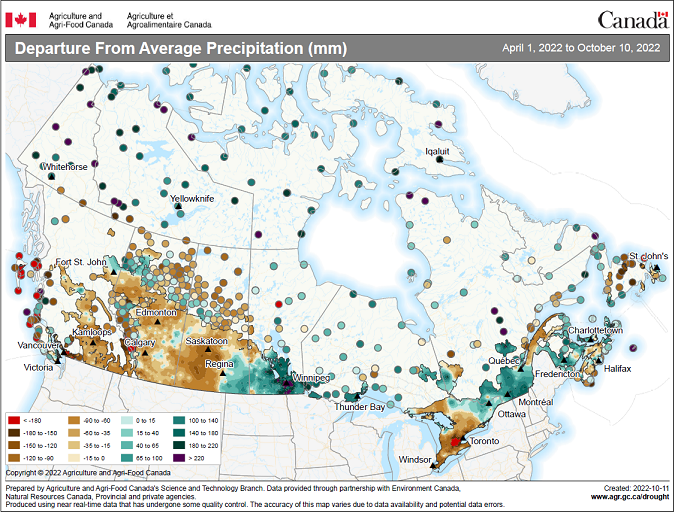Production of principal field crops, November 2022
Released: 2022-12-02
Canadian farmers reported producing more wheat, canola, barley, corn for grain, soybeans, and oats in 2022 compared with 2021. Higher production was driven largely by better yields, especially in western Canada where growing conditions were generally more favourable than in 2021.
Throughout 2022, better growing conditions relative to 2021 across much of western Canada contributed to improved yields. Despite the general improvement over 2021, dry soil conditions persisted in many parts of the Prairies, affecting growing conditions in those regions. In eastern Canada, conditions in the southern part of Ontario were drier than normal, while in eastern parts of the province, most of Quebec and parts of Atlantic Canada received above-average precipitation.
Good conditions allowed farm operators to complete harvest in a timely manner across most of the country.
Wheat harvest is the third largest on record
Total wheat production rose by 51.7% to 33.8 million tonnes in 2022, the highest production since 2020 and the third highest production on record, largely attributable to higher production in the Prairies. Yields (+38.2% to 49.9 bushels per acre) and harvested area (+9.7% to 24.9 million acres) were both up from a year earlier.
In Saskatchewan, wheat yields increased by 47.3% to 41.4 bushels per acre in 2022, while harvested area rose by 13.5% to 13.1 million acres, resulting in a 67.2% rise in wheat production to 14.8 million tonnes.
Alberta wheat production climbed by 76.7% to 11.3 million tonnes. Yields increased by 59.8% to 55.6 bushels per acre, while harvested area rose by 10.6%. Wheat yields in the province were at their highest level since 2020 and above the five-year average of 49.2 bushels per acre from 2017 to 2021, as timely precipitation contributed to greater production.
Both yields (+21.3% to 58.1 bushels per acre) and harvested area (+4.7% to 3.0 million acres) increased in Manitoba, resulting in a 26.9% increase in production to 4.8 million tonnes.
Canola production rises despite lower harvested area
Canola production increased by 32.1% nationally to 18.2 million tonnes in 2022. Yields increased by 37.6% to 37.7 bushels per acre, while harvested area fell 3.9% to 21.2 million acres.
Canola yield in Saskatchewan increased by 48.0% to 37.0 bushels per acre, offsetting lower harvested area (-4.8% to 11.4 million acres), resulting in a 41.0% production increase to 9.5 million tonnes. Despite better growing conditions overall, conditions in the southwestern and west-central parts of the province remained dry, possibly impacting provincial production.
In Alberta, canola production was up 28.8% to 5.6 million tonnes, due to higher yields (+31.8% to 38.1 bushels per acre) offsetting lower harvested area (-2.2% to 6.5 million acres).
In Manitoba, canola production rose 14.4% to 2.9 million tonnes. Harvested area decreased by 5.0% to 3.2 million acres, while yields rose 20.5% to 39.4 bushels per acre.
Corn for grain production rises on higher harvested area
Nationally, the total corn for grain production rose 4.0% to a record-high 14.5 million tonnes in 2022. Harvested area rose 3.8% to 3.6 million acres, while yields edged up 0.2 bushels per acre to 160.4 bushels per acre.
Ontario farmers reported that harvested area increased by 5.2% to 2.2 million acres in 2022, but were offset by lower yields, which fell 5.3% to 166.0 bushels per acre, bringing production down 0.4% from 2021 to 9.4 million tonnes. Lower yields were likely the result of dry conditions in southern Ontario, where most of the corn in the province is grown.
Corn for grain production in Quebec was up 4.1% in 2022 from the previous year to 3.6 million tonnes. Harvested area rose 0.4% to 885,700 acres while yields increased 3.7% to 158.3 bushels per acre.
Soybean production rises
Soybean production increased by 4.3% nationally to 6.5 million tonnes in 2022. A 0.7% decrease in harvested area was offset by a 5.0% increase in yields.
Ontario soybean production fell 2.1% to 4.0 million tonnes. Higher harvested area (+5.2% to 3.1 million acres), was offset by lower yields (-7.0% to 48.0 bushels per acre).
In Manitoba, yields rose to a record-high 43.0 bushels per acre (+58.7%) in 2022 because of better growing conditions likely due to higher precipitation compared with 2021. Harvested area fell 13.8% to 1.1 million acres, resulting in a 36.8% increase in production to 1.3 million tonnes in 2022.
Soybean production in Quebec rose 2.2% from a year earlier to 1.1 million tonnes. A decrease in yield (-1.1% to 43.7 bushels per acre) was offset by a 3.2% increase in harvested area.
Barley and oat production rise
Barley production rose 43.5% to 10.0 million tonnes in 2022. While harvested area fell (-12.3% to 6.5 million acres), yields rose (+63.7% to 70.4 bushels per acre) because of better growing conditions in western Canada.
Total oat production increased by 86.1% nationally to 5.2 million tonnes, on higher harvested areas (+19.2% to 3.5 million acres) and higher yields (+56.2% to 97.8 bushels per acre).
Note to readers
The November 2022 Field Crop Survey about crop production is sent to approximately 27,200 Canadian farms and was conducted from October 7 to November 14, 2022. Farmers were asked to report their estimated seeded and harvested areas, yields and production of grains, oilseeds and special crops. This survey collected data from every province.
This release provides the final production estimates for 2022, which are subject to revision for two years.
Additional data sources
Readers are invited to visit the Crop Condition Assessment Program web application, which is an additional tool to assess growing conditions of field crops during the crop year. Readers can monitor a vegetation index of crop land on a weekly basis.
Contact information
For more information, or to enquire about the concepts, methods or data quality of this release, contact us (toll-free 1-800-263-1136; 514-283-8300; infostats@statcan.gc.ca) or Media Relations (statcan.mediahotline-ligneinfomedias.statcan@statcan.gc.ca).
- Date modified:


